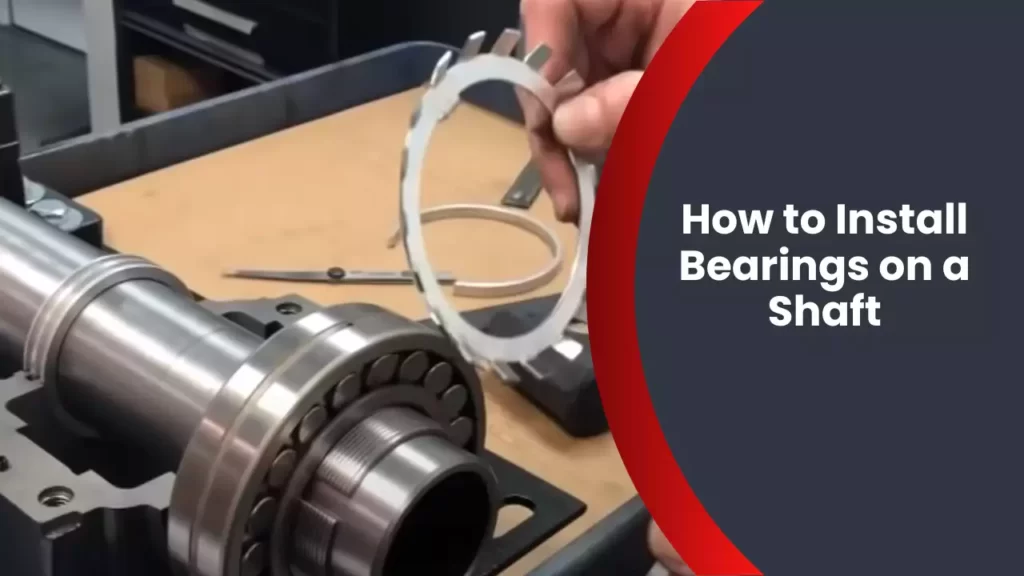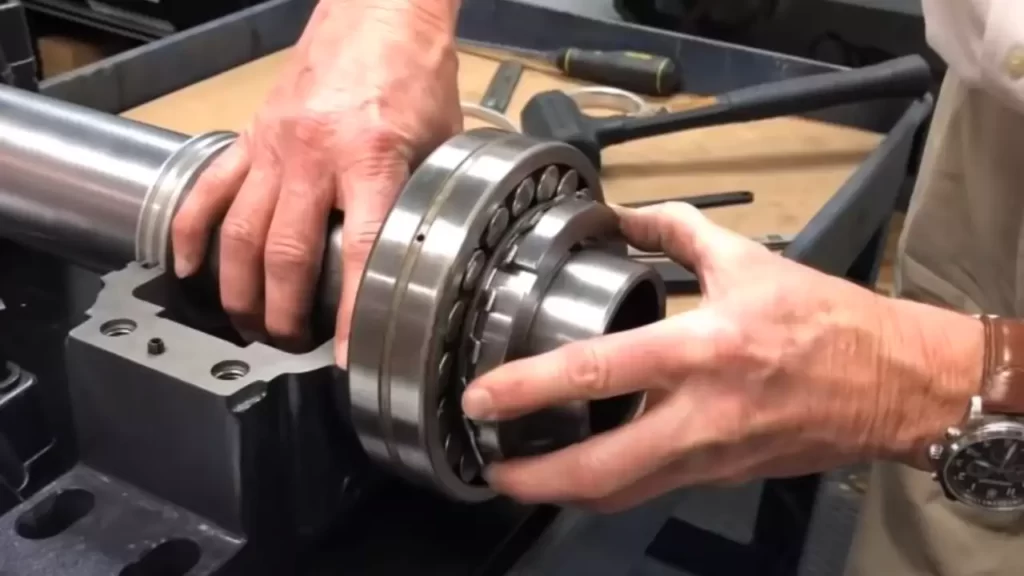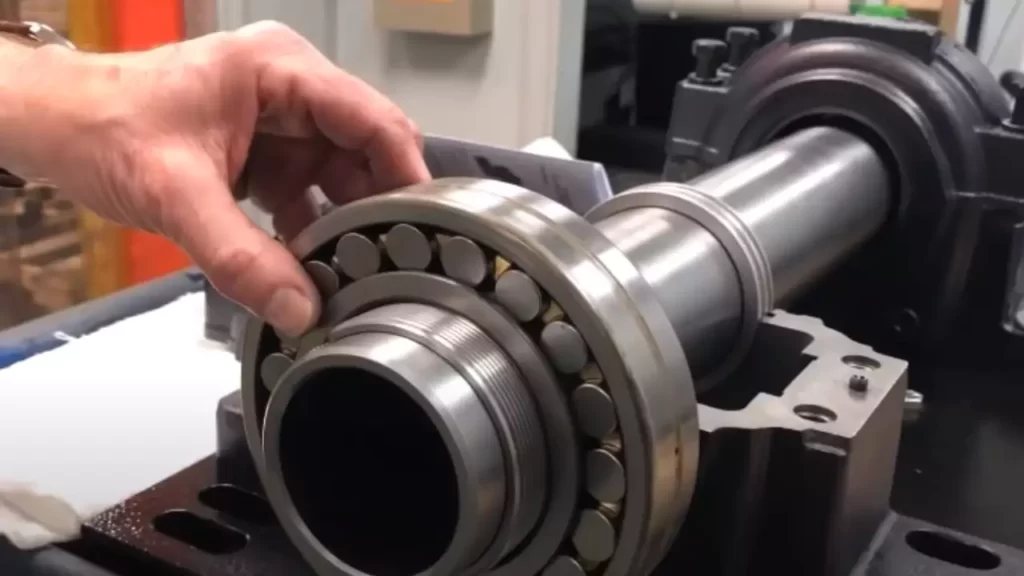To install bearings on a shaft, begin by cleaning the shaft and bearing thoroughly to remove any debris. Then, apply a thin layer of lubricant to the shaft and insert the bearing, ensuring it is properly aligned.
Press the bearing onto the shaft using a press machine or a hammer, making sure it is securely in place. Finally, check for any misalignment or tightness, and make any necessary adjustments.
Getting Started With Bearing Installation
If you want your machinery to run smoothly and efficiently, proper bearing installation is of utmost importance. Whether you’re replacing old worn-out bearings or installing new ones, it’s crucial to follow the correct procedure to ensure optimal performance and longevity. In this guide, we’ll walk you through the process of installing bearings on a shaft, starting with the importance of proper bearing installation.
Importance of Proper Bearing Installation
Proper bearing installation plays a significant role in the overall performance and durability of your machinery. When bearings are installed correctly, they endure less stress and friction, enabling them to function optimally.
On the other hand, if bearings are improperly installed, it can lead to a range of issues, including premature wear, increased noise, excessive vibration, and even complete failure. These problems can result in costly repairs, production downtime, and compromised equipment functionality.
To prevent such complications, it’s crucial to understand the importance of proper bearing installation and adhere to the recommended procedures.
Tools and Equipment Needed
Before you begin the bearing installation process, gather the necessary tools and equipment to ensure a smooth and efficient procedure. Here are the key tools you’ll need:
- A rubber mallet or hammer
- A suitable bearing press
- A bearing puller
- A torque wrench
- Bearing grease
- A clean cloth or rag
Make sure you have all these tools readily available before you start installing the bearings to avoid any delays or interruptions in the process.
Once you have gathered the necessary tools, you’ll be well-prepared to tackle the bearing installation process with confidence.

Preparing The Shaft For Installation
Before installing bearings on a shaft, it is crucial to properly prepare the shaft to ensure optimal performance and longevity. This involves cleaning the shaft surface and checking its dimensions to ensure it meets the required specifications. By following these steps, you can ensure a smooth installation process and prevent any potential issues down the line.
1. Cleaning the Shaft Surface
One of the first steps in preparing the shaft for bearing installation is to clean the shaft surface thoroughly. Any contaminants or debris on the shaft can negatively affect the performance and lifespan of the bearings. To clean the shaft surface:
- Start by wiping the shaft with a lint-free cloth to remove any loose dirt or particles.
- Next, use a degreaser or solvent recommended by the manufacturer to remove any grease or oil residue.
- Ensure that the cleaning agent used does not leave behind any residue that could interfere with the bonding of the bearing onto the shaft.
- After cleaning, inspect the shaft surface visually to ensure it is free from any visible contaminants.
2. Checking Shaft Dimensions
In addition to cleaning the shaft surface, it is essential to check its dimensions to confirm it meets the required specifications for bearing installation. This step will help identify any potential issues that may affect the performance of the bearings. Follow these steps to check the shaft dimensions:
- Measure the diameter of the shaft using a micrometer or caliper. Ensure the measurements are accurate and consistent throughout.
- Compare the measured diameter to the specifications provided by the bearing manufacturer. Verify that it falls within the recommended tolerance range.
- Check for any surface irregularities or damage on the shaft that could impact the proper functioning of the bearings.
- If any deviations or irregularities are found, consult with a professional to determine the appropriate course of action.

Installing The Bearings
Installing bearings on a shaft is a crucial process that requires careful attention to detail. Proper installation ensures the longevity and smooth functionality of your machinery or equipment. In this section, we will explore the key steps involved in installing bearings, including choosing the right bearing type, lubricating the bearings, using the press-fit method, employing heating and cooling techniques, and utilizing bearing installation tools.
Choosing the Right Bearing Type
Choosing the right bearing type is essential for successful installation. With a myriad of bearing options available, selecting the appropriate type will depend on various factors such as load capacity, rotational speed, operating conditions, and required accuracy. Ball bearings, roller bearings, and tapered roller bearings are common options, each offering distinct advantages depending on the application.
Lubricating the Bearings
Proper lubrication plays a vital role in bearing performance and longevity. Lubrication reduces friction and prevents wear and tear, ensuring smoother rotation. Before installing the bearings, make sure to choose the right lubricant based on factors like temperature, speed, and load. Applying a thin, even layer of lubricant between the bearing and the shaft is crucial to maximize efficiency and minimize heat generation.
Press-Fit Method
The press-fit method is a widely-used technique for installing bearings onto a shaft. This method involves fitting the bearing tightly onto the shaft using mechanical force. To ensure a proper press fit, clean the shaft and bearing thoroughly and ensure they are free from dirt and debris. By carefully applying force using a press or other suitable tools, the bearing can be securely mounted onto the shaft.
Heating and Cooling Techniques
Heating and cooling techniques can aid in the proper installation of bearings. Heating the bearing expands it slightly, allowing for easier fitting onto the shaft. Conversely, cooling the shaft can cause slight contraction, facilitating smooth insertion of the bearing. These techniques can be particularly useful for large or tight-fitting bearings. However, it is important to exercise caution and avoid excessive temperature changes to prevent damage to the bearing or shaft.
Using Bearing Installation Tools
Utilizing the right bearing installation tools can simplify and streamline the installation process. Tools such as bearing pullers, mounting plates, and hydraulic presses can provide the necessary force and precision required for proper bearing installation. These tools help minimize the risk of damage to the bearing or shaft and ensure accurate alignment during the installation process.
Successfully installing bearings on a shaft requires careful consideration of factors such as bearing type selection, proper lubrication, the use of the press-fit method, heating and cooling techniques, and appropriate tools. By following these steps and paying attention to detail, you can ensure smooth operations and maximize the lifespan of your machinery.

Troubleshooting And Maintenance
If you want to ensure the smooth operation of your machinery, proper troubleshooting and maintenance of bearings is crucial. Bearing installation issues can lead to premature failure and costly repairs. In this section, we will discuss some common bearing installation issues, the importance of proper bearing alignment, and the significance of regular inspection and maintenance. By addressing these aspects, you can extend the lifespan of your bearings and maintain the efficiency of your equipment.
Common Bearing Installation Issues
During the installation process, certain issues may arise that can negatively impact the performance of the bearings. By being aware of these issues, you can take proactive measures to prevent them. Here are some of the common bearing installation issues to look out for:
- Insufficient lubrication: Proper lubrication is essential for reducing friction and wear between the bearing and the shaft. Without adequate lubrication, the bearings can seize or wear out prematurely, leading to failure.
- Incorrect fitting: Using the wrong size or type of bearing for your shaft can result in poor performance and premature failure. It is crucial to choose the correct bearing that matches the specifications of your equipment.
- Improper handling: Mishandling bearings during installation can damage the rolling elements or the bearing races. It is essential to follow proper handling procedures to prevent any unnecessary damage.
- Excessive preload: Applying too much preload to the bearings can cause excessive heat generation and premature failure. It is important to follow the manufacturer’s recommendations and ensure the proper preload is applied.
Proper Bearing Alignment
For optimal performance and longevity, proper alignment between the bearing and the shaft is crucial. Misalignment can lead to increased stress on the bearings, resulting in premature wear and failure. Here are some important points to consider for proper bearing alignment:
- Align the shaft and bearing housing: Ensuring that the shaft and bearing housing are properly aligned will help distribute the load evenly and reduce unnecessary stress on the bearings.
- Check for parallelism and concentricity: The shaft and housing should be checked for parallelism and concentricity to achieve proper alignment. Using alignment tools and techniques can help achieve this alignment accurately.
- Regularly monitor alignment: Over time, machinery vibrations and other factors can cause misalignment. Regularly monitoring the alignment and making adjustments as needed will help prevent bearing issues and improve overall machinery performance.
Regular Bearing Inspection and Maintenance
To ensure the longevity and reliability of your bearings, regular inspection and maintenance are essential. By incorporating these practices into your maintenance routine, you can catch any potential issues early on and prevent costly breakdowns. Here are some key aspects to consider for regular bearing inspection and maintenance:
- Periodic lubrication checks: Regularly inspecting and replenishing the lubrication in your bearings will help maintain optimal performance and prevent premature wear.
- Clearing contaminants: Removing any contaminants such as dust, dirt, or debris from the bearing housing will help prevent damage and extend the lifespan of the bearings.
- Monitoring temperature: Keeping an eye on the temperature of the bearings during operation can provide early indications of potential issues. Unusual temperature fluctuations may indicate problems such as insufficient lubrication or excessive friction.
- Inspection for wear and damage: Regularly inspecting the bearings for signs of wear, pitting, or other damage can help identify any issues before they escalate. If any abnormalities are detected, it is important to take immediate action.
By addressing these common bearing installation issues, ensuring proper alignment, and regularly inspecting and maintaining your bearings, you can minimize downtime, prevent costly repairs, and ensure the efficient performance of your machinery. Proactively taking care of your bearings will not only save you time and money but also improve the overall productivity of your equipment.
Frequently Asked Questions
What Tool Is Used To Install A Bearing On A Shaft?
A bearing installation tool is used to install a bearing on a shaft efficiently and accurately. It ensures a secure and proper fit, reducing the risk of damage and ensuring smooth operation. This tool helps save time and effort during the installation process.
What Is The First Step To Installing A Bearing?
The first step to installing a bearing is to choose the correct size and type of bearing for your application. This ensures a proper fit and functionality.
How Do You Press Fit Bearings?
Press fitting bearings requires a careful process: 1. Heat the bearing and freeze the housing to create a temperature difference. 2. Place the bearing into the housing and apply pressure evenly. 3. Utilize press tools or hydraulic presses for accurate and controlled force.
4. Avoid excessive force to prevent damage. 5. Ensure proper alignment for a secure fit.
How Is The Location Of A Bearing Chosen On A Shaft?
The location of a bearing on a shaft is chosen based on factors like load, speed, and alignment. It should be positioned where it can handle the expected forces and provide optimal support. Careful consideration of these factors ensures effective functioning of the bearing and prevents premature failure.
Conclusion
To sum up, installing bearings on a shaft may seem daunting, but with the right steps and tools, it can be a straightforward process. By following these guidelines and taking the necessary precautions, you ensure the longevity and efficiency of your machinery.
Remember to always refer to the manufacturer’s instructions for specific guidance. With practice and patience, you’ll become proficient in installing bearings and keep your systems running smoothly. So, put your knowledge to the test and enjoy the satisfaction of a job well done!
